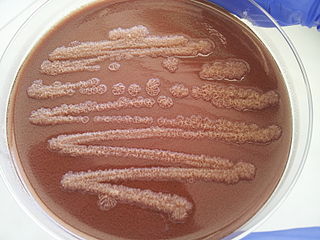
Pseudomonas is a genus of Gram-negative, Gammaproteobacteria, belonging to the family Pseudomonadaceae and containing 191 validly described species. The members of the genus demonstrate a great deal of metabolic diversity and consequently are able to colonize a wide range of niches. Their ease of culture in vitro and availability of an increasing number of Pseudomonas strain genome sequences has made the genus an excellent focus for scientific research; the best studied species include P. aeruginosa in its role as an opportunistic human pathogen, the plant pathogen P. syringae, the soil bacterium P. putida, and the plant growth-promoting P. fluorescens, P. lini, P. migulae, and P. graminis.

Pseudomonas fluorescens is a common Gram-negative, rod-shaped bacterium. It belongs to the Pseudomonas genus; 16S rRNA analysis as well as phylogenomic analysis has placed P. fluorescens in the P. fluorescens group within the genus, to which it lends its name.
Pseudomonas putida is a Gram-negative, rod-shaped, saprotrophic soil bacterium.
Pseudomonas alcaligenes is a Gram-negative aerobic bacterium used for bioremediation purposes of oil pollution, pesticide substances, and certain chemical substances, as it can degrade polycyclic aromatic hydrocarbons. It can be a human pathogen, but occurrences are very rare. Based on 16S rRNA analysis, P. alcaligenes has been placed in the P. aeruginosa group.
Pseudomonas chlororaphis is a bacterium used as a soil inoculant in agriculture and horticulture. It can act as a biocontrol agent against certain fungal plant pathogens via production of phenazine-type antibiotics. Based on 16S rRNA analysis, similar species have been placed in its group.
Acidovorax facilis is an aerobic, chemoorganotrophic bacterium used as a soil inoculant in agriculture and horticulture.
Pseudomonas fuscovaginae is a fluorescent, Gram-negative soil bacterium that is pathogenic to rice, causing brown sheath rot. The type strain is CCUG 32780.
Pseudomonas brassicacearum is a Gram-negative soil bacterium that infects the roots of Brassica napus, from which it derives its name. Based on 16S rRNA analysis, P. brassicacearum falls within the P. fluorescens group. It has also been shown to have both pathogenic and plant growth-promoting effects on tomato plants.
Pseudomonas citronellolis is a Gram-negative, bacillus bacterium that is used to study the mechanisms of pyruvate carboxylase. It was first isolated from forest soil, under pine trees, in northern Virginia, United States.
Pseudomonas xanthomarina is a bacterium found in marine ascidians. Unlike many other members of the genus Pseudomonas, it is not fluorescent.
Pseudomonas moraviensis is a Gram-negative soil bacterium. It is named after Moravia, the region of the Czech Republic where it was first isolated. The type strain is CCM 7280T.
Pseudomonas vranovensis is a Gram-negative soil bacterium.
Pseudomonas jinjuensis is a Gram-negative, non-spore-forming, motile, single polar flagellated, yellow-white, rod bacterium isolated from soil in the Jinju Region of Korea. The type strain is LMG 21317.
Pseudomonas koreensis is a Gram-negative, non-spore-forming, motile, multiple polar flagellated, yellow-white, rod bacterium isolated from farming soil in Korea. The type strain is LMG 21318.
Pseudomonas umsongensis is a Gram-negative, non-spore-forming, motile, single polar-flagellated, yellow-white, rod-shaped bacterium isolated from the soil in the Umsong region of Korea. The type strain is LMG 21317.
Pseudomonas kilonensis is a Gram-negative soil bacterium isolated from agricultural soil in Germany. The type strain is DSM 13647.
Pseudomonas lini is a fluorescent, Gram-negative, rod-shaped bacterium isolated from rhizospheric soil in France. The type strain is CFBP 5737, though there are also eight other strains known. This bacterium has also been isolated from endophytic tissues of lodgepole pine trees growing on gravel mining sites with potential to perform biological nitrogen fixation and plant growth promotion.

Pseudomonas stutzeri is a Gram-negative soil bacterium that is motile, has a single polar flagellum, and is classified as bacillus, or rod-shaped. While this bacterium was first isolated from human spinal fluid, it has since been found in many different environments due to its various characteristics and metabolic capabilities. P. stutzeri is an opportunistic pathogen in clinical settings, although infections are rare. Based on 16S rRNA analysis, this bacterium has been placed in the P. stutzeri group, to which it lends its name.

2,4-Diacetylphloroglucinol or Phl is a natural phenol found in several bacteria:
Pseudomonas protegens are widespread Gram-negative, plant-protecting bacteria. Some of the strains of this novel bacterial species previously belonged to P. fluorescens. They were reclassified since they seem to cluster separately from other fluorescent Pseudomonas species. P. protegens is phylogenetically related to the Pseudomonas species complexes P. fluorescens, P. chlororaphis, and P. syringae. The bacterial species characteristically produces the antimicrobial compounds pyoluteorin and 2,4-diacetylphloroglucinol (DAPG) which are active against various plant pathogens.



